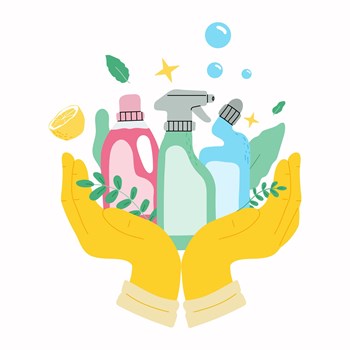
Cleaning products are designed with a straightforward goal: to reduce dirt and grime. But once you delve deeper into their overall purpose, things become more complex. What makes something really clean? Does it just look shinier? Smell better? After all, cleanliness can be subjective, depending on individual priorities and standards. Can the products and processes building staff use every day to maintain the common spaces in multifamily buildings be healthier in a more objective sense—an antibacterial, net-positive sense?
If your priority is keeping things in pristine condition with less impact on the environment, it just so happens that there are many effective products on the market that make use of environmentally-friendly ingredients instead of chemicals that simply provide that familiar ‘clean’ lemony-pine-bleach smell without breaking the bank. Oftentimes, these products are less toxic and irritating than their harsher, more chemically complex competitors, and can be ordered in bulk for larger buildings and associations - though finding the right product, tool, or technology for your needs may require some searching.
Revamping Your Routine
There’s a treasure trove of information available online about exactly what big-name cleaning manufacturers are doing to curb their carbon footprint and provide non-toxic, ‘greener’ cleaning products to the marketplace. If your association or cleaning services vendor has been using one specific supplier for years and years, it may be worth reviewing the products and methods they use in your building or association to see how they have evolved with changing priorities.
“The first thing anyone should do is go online and research which products are green,” says Matt Heiden of Condo Care Inc., in Des Plaines, Illinois. “For example, Windex is green, and Mr. Clean is a green product. They’ll usually have the well-known recyclable symbol prominently displayed. The main thing that you want to avoid are aerosols, which are really the killer. Those and oil-based products. A lot of people don’t like those two.”
What to Avoid
According to the Environmental Protection Agency (EPA), the most dangerous chemicals commonly found in cleaning products are volatile organic compounds, or VOCs. These include phosphorus, nitrogen and ammonia. VOCs are found in the majority of cleaning products, and are the worst offenders when it comes to environmental contamination. While the majority of pollutants are removed by waste treatment processes, these three chemicals are not. And their impact is felt far beyond the spaces they’re intended to clean; for example, phosphates in laundry and dishwasher detergent trigger the widespread growth of algae in wetlands and waterways. This reduces oxygen levels in the water, which makes for poor quality water that’s unfit for drinking, bathing, and recreation, as well as harmful to wildlife.
Furthermore, even after cleaning, when you open windows to ventilate your space, toxic chemicals are released into the air. New regulations limit the amounts of VOCs in existing non-eco-friendly cleaning products to reduce this problem.
Of course, aerosol products are notorious for their adverse environmental effects, and can be harmful if inhaled directly. Aerosols are also easy to avoid, thanks to the many alternatives available. “High-pressure aerosols, like Lysol, should be avoided,” says Heiden. “You can easily make a disinfectant solution and put it in a regular spray bottle. On the other hand, bleach is bad for you, but you often cannot get around using it; it’s the only thing that really does its specific job.”
The Smell of Sustainability
While a lack of scent may indicate that a product is all-natural, there are organic ingredients that can add a pleasant smell to your hallways or foyer. “We have used a wide array of products that are hydrogen peroxide based, and safe for all surfaces,” says Walter, a field manager for UrbanMaidGreen, a green cleaning company in New York City. (He requested that his last name not be used). “There is a light hint of apple in our window cleaner, and a touch of pine in our all-purpose cleaner. Both are natural and organic. The smells of the synthetic products linger; with the organic stuff, it isn’t as pungent.”
There may be a learning/acceptance curve when incorporating new products, especially if those products don’t smell like the more old-school products to which many folks are more accustomed. Again, people associate certain scents with cleanliness, especially from sense memories acquired over time. These can be tough to shake. Caustic as they are, the smells of ammonia and bleach are powerfully suggestive of deep, thorough cleaning, and some residents (and staff) feel that if the lobby doesn’t reek of bleach after it’s mopped, then it isn’t really clean.
Daniel Wollman, CEO of Gumley Haft, a New York City-based management company observes that “Some may think certain green supplies are not as effective as more standard cleaning supplies. The process is different with greener products,” he explains. “It may take more time, and may take repeated attempts to clean the target area. That doesn’t mean we shouldn’t try using them consistently. New products come out, and they continue to improve,” he says.
“Many people think that things that don’t ‘smell clean’ are not, in fact, clean,” says Neil Betoff, founder and president of STAR Building Services in Shrewsbury, New Jersey. “The problem with that is, when you add fragrances to products, it diminishes their green value. So, a lack of smell may better indicate cleanliness. Many people appreciate the smell of bleach, for instance, which is not environmentally friendly.”
Outside of the little three-arrow symbol indicating that a product is recyclable, there are other stamps for which a green-conscious buyer should look. Bob Branscombe, director of sales and marketing with Champion Cleaning in North Chelmsford, Massachusetts, recommends checking for third-party endorsements such as Green Seal, ECOLOGO, or the EPA.
“Many products nowadays are extremely good and effective,” Branscombe says. “They’re loaded with surfactants [substances that reduce the surface tension of a liquid in which they’re dissolved], as opposed to harsh solvents, and many of the green cleaners are hydrogen peroxide-based. So, what I tell cleaning companies or customers is, look at the products that you’re currently using and see if there’s a better alternative. And a lot of distributors and manufacturers are willing to let you try samples as well. So, you can get a bottle of, for example, the latest Clorox Green Works, or something similar, and see if that works for you.”
Advanced Tools & Techniques
Outside of various sprays and disinfectants, there are tools and techniques that can contribute to a green cleaning practice.
“We use the SH-Mop, which is similar to a Swiffer, but with a larger, 8x10-ish pad,” notes Walter. “It’s huge, and uses a microfiber rag, so it’s not harsh on the floor, like a heavy mop would be. It’s a great asset.”
“There’s a system that you can buy that ionizes regular water, converting it into a disinfectant cleaner,” adds Betoff. “The system itself is expensive to purchase, but water is basically free, so, depending on the size of your building, it could eventually pay for itself. That said, there’s one challenge in that, when you ionize the water and put it into cleaning bottles, it doesn’t have a long shelf life - around 48 hours. Past that, you have to dump it out and start again.”
Betoff also recommends utilizing backpack vacuums. “They’re more environmentally friendly than the upright alternative, as they don’t beat the carpet with a brush. It’s also important that a vacuum have a HEPA filter, which is a filtration system that doesn’t put dust back into the air.” And, much like the SH-Mop, Betoff uses a treated microfiber cloth when dusting, instead of an ordinary dustrag - the dust particles stick to the cloth, instead of simply being scattered and relocating around the room.
For his part, Branscombe suggests what’s called a dilution control system. “If you’re buying a ready-to-use product, the product is diluted at the factory, so in effect you’re paying for the shipping of water,” he explains. “That ready-to-use formula is all well and good, because you don’t have to train anyone how to develop it or to use it; it’s good to go out of the bottle. But with companies like ours that use a lot of cleaning products, it’s to everybody’s economic advantage, as well as the earth’s general advantage, to buy it in concentrate and hook it up to a dilution control system, where it’s pre-measured. Nobody has to do anything, not even tweak it; it just comes out as it should. And the systems available nowadays are just terrific; there are a ton to pick from.”
Avoiding ‘Greenwashing’
While some products make no pretense of being environmentally friendly, others have packaging that is a bit harder to interpret. Greenwashing can occur through misleading labels, vague claims, or overstated environmental benefits, leading consumers to believe they are making eco-friendly choices when they may not be. For that reason, it’s useful for eco-conscious buyers to know what types of products to look out for to avoid ones that are not quite as green as advertised—or that are just downright ineffective.
“Greenwashing is when somebody sells you on the fact that they’re using a green product, despite not actually doing that,” says Branscombe. “It’s what we see most often. It’s not necessarily the labeling of the product, so much as it’s a company saying on its website that they use green cleaning products, and then you bump into their crew at a property walk-through, and they’re using Formula 409 or some butyl-based solvent cleaner to do their everyday wipe-down. You can usually get the sense in these situations that something is not right.”
“Greenwashing is a marketing tactic that everyone should be informed about,” Wollman agrees. “Labeling something green when it might just be overly diluted or —believe it or not—maybe just colored green doesn’t make it eco-friendly. Sadly, one top-selling brand with ‘Green’ in its name —and that most people assume is eco-friendly—still makes products containing butyl, a carcinogen.” Wollman says that “When in doubt, check to see if the product has third party green certification such as the EPA’s Safer Choice, UL’s EcoLogo and Green Seal, to name a few.”
“I’ll never use anything that has ‘organic’ written on it ever again,” says Heiden. “They’re terrible, and don’t clean anything; you may as well just use a bucket of water. They’re extremely expensive, and they’re only sold in small bottles. When you’re a commercial cleaner, you can’t buy in such small volume. So, anything that leads with ‘organic’ I just completely avoid. I’ve tried them all, and they have, in my experience, made the job harder.”
On the flip side of the coin, Betoff warns about the perceived effectiveness of the ever-popular bleach. “Everybody thinks that if you smell bleach in a bathroom, that bathroom is clean and sanitized; that there are no germs anywhere. But this is by no means the case.”
Wollman notes that in one of the more ‘green-conscious’ buildings his firm manages, a condominium in Manhattan, the building staff replaced all the cleaning products they formerly used throughout the building with Simple Green All Purpose Cleaner. Simple Green is diluted with water, and its product statements say it is safe for children and pets. “In fact,” says Wollman, “though the Simple Green product line is slightly more expensive than what they used before, [the superintendent] says it’s worth it.”
And Walter notes that, if you simply focus on cleaning regularly and maintaining a consistent level of hygiene in your spaces, you won’t even have to consider harsher chemicals. “[Those chemicals] come into play in a bathroom once someone has accrued soap scum, or a ring around the tub, for example” he says. “But, if you keep things maintained, the greener products will be entirely sufficient.”
Whether your primary concern is the planet, the state of your lobby tile, or the safety and comfort of yourself and your family, using the most effective, greenest, and most-economical options for cleaning common areas and other places where people gather is something you should take an interest in.






Leave a Comment